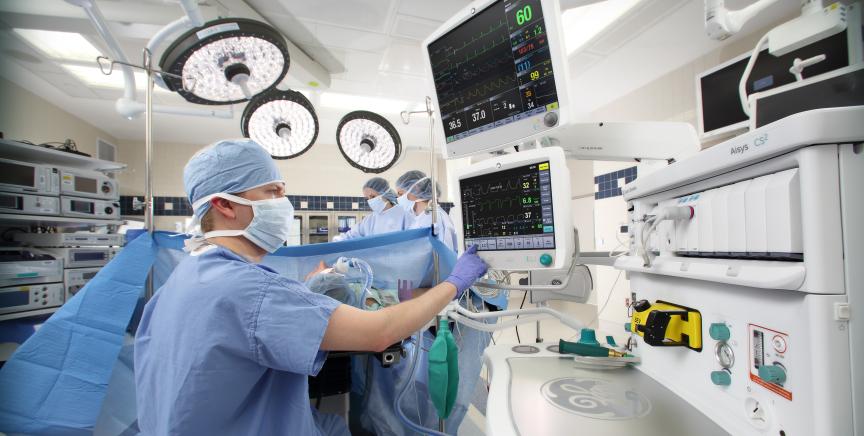
Depth of Anesthesia and POCD
First described in 1955, postoperative cognitive impairment and its potential connection to general anesthesia exposure have generated a substantial amount of research.
This research has focused on multiple possible cognitive effects such as postoperative cognitive dysfunction (POCD), the development of dementia, and a decline in cognitive function in patients with pre-existing dementia.
In 2018, Hou et al. investigated patients aged 60 and older without pre-existing dementia scheduled to undergo elective total knee replacement[1].
The team then randomized these patients based on depth of anesthesia through the use of brain monitoring. Analgesic requirements were controlled for using femoral and sciatic nerve blocks and hemodynamic targets and inducts were standardized in both “light” and “deep” anesthesia groups.
All patients received anesthetics including sevoflurane and Propofol infusion titrated to the appropriate BIS.
Yet, when cognitive performance was measured using the Montreal cognitive assessment (MoCA) on postoperative day one, patients in the deep anesthesia group performed significantly worse.
These results suggest that “a greater depth of anesthesia may increase POCD in the immediate postoperative period when other factors are carefully controlled.”[2]
The Intersection of Anesthetics and Genetics
Yet, as previously stated, the relationship between anesthesia depth and cognitive outcomes is complex with researchers theorizing that some patients may have higher susceptibility to deleterious sequel than others.
One meta-analysis published in 2014, concluded that patients who carry the APOEε4 allele, a gene implicated in AD susceptibility, are at higher risk of POCD one-week postoperatively[3].
A second study of patients (n = 180) with amnestic mild cognitive impairment (MCI) who underwent lumbar spinal surgery found an accelerated progression of amnestic MCI to progressive MCI with sevoflurane use[4].
These studies indicate that pre-existing cognitive impairment may combine with other issues such as depth of anesthesia to negatively impact the risk of POCD and increase postoperative morbidity.
Delirium and the Unintended Consequences of Anesthesia
Delirium is one possible presentation of POCD as a neurocognitive consequence associated with general anesthesia and has been widely studied on its own as well as under the umbrella of cognitive dysfunction.
Though generally considered temporary, studies show that delirium can negatively impact cognition for months or even years, far beyond a patient’s initial recovery from surgery.[5]
Additionally, on average patients who suffer from delirium post-operatively have a steeper rate of cognitive decline over many years than the non-delirium group.[6]
This means that initial delirium and long-term cognitive dysfunction may go hand-in-hand.
Unfortunately, delirium has been shown to be an unintended consequence of anesthesia, especially deep anesthesia.
- An issue in both inhaled and intravenous agents - A 2013 study concluded that emergence delirium and postoperative delirium “can develop in association with use of inhalation anesthetics and intravenously administered anesthetics”.[7]
- Increased complications with age - An article by Abbott et al published in JAMA concluded that “Postoperative delirium is a common and important complication for older patients and may relate to the dose of anesthesia drugs used during surgery.”[8]
- Monitoring required due to neurochemical changes - Results of a 2015 study report titled “Depth of Anesthesia and Postoperative Delirium” concluded that due to the profound neurochemical changes use of anesthetics produce which can result in disruption of normal brain function, these drugs may result in postoperative delirium. The study also called for brain monitoring to control anesthesia depth, avoid sedative drugs overdose and prevent postoperative delirium.[9]
Taken together, all of these studies demonstrate the undeniable neurocognitive dangers of unnecessarily deep anesthesia.
Avoiding Overuse of Anesthetics during Surgery
Fortunately, research has also provided valuable insights into how to prevent overuse of anesthetic agents during surgery using EEG. This brain function monitoring can help the anesthesiologist find the balance between enough medication to prevent awareness, but not greater than needed.
A study reported in the Journal of Neurosurgical Anesthesiology found that use of EEG reduced propofol delivery by 21% and volatile anesthetics by 30%, lowering the rate of POCD at three months compared with routine care.[10]
A second randomized controlled trial (n = 689 blinded) found that the percentage of episodes of deep anesthesia were independently predictive for postoperative delirium. The researchers concluded that intraoperative neuromonitoring is associated with a lower incidence of delirium, possibly through the reduction of deep anesthesia.[11]
Additionally studies have also suggested that EEG monitoring, specifically through the use of Entropy may significantly reduce the consumption of propofol and/or sevoflurane.[12] This may lead to reduced postoperative delirium through avoidance of burst suppression.[13]
Putting Patient Safety First Through Monitoring
Further research is still needed to determine associated risk factors for cognitive decline and pinpoint interventions to lower the neurocognitive consequences of anesthesia, especially in frail or susceptible patients. However, implementation of proven strategies, like EEG monitoring through entropy, has the potential to reduce the risk of postoperative cognitive decline and delirium for the over 234 million patients who undergo surgical procedures each year.[14]
References
[1] Hou R, Wang H, Chen L, Qiu Y, Li S. POCD in patients receiving total knee replacement under deep vs light anesthesia: a randomized controlled trial. Brain Behav. 2018; 8:e00910.
[2] Belrose, J.C., Noppens, R.R. Anesthesiology and cognitive impairment: a narrative review of current clinical literature. BMC Anesthesiol 19, 241 (2019). https://doi.org/10.1186/s12871-019-0903-7
[3] Cao L, Wang K, Gu T, Du B, Song J. Association between APOE epsilon 4 allele and postoperative cognitive dysfunction: a meta-analysis. Int J Neurosci. 2014;124:478–85.
[4] Belrose, J.C., Noppens, R.R. Anesthesiology and cognitive impairment: a narrative review of current clinical literature. BMC Anesthesiol 19, 241 (2019). https://doi.org/10.1186/s12871-019-0903-7
[5] Inouye SK, Marcantonio ER, Kosar CM, Tommet D, Schmitt EM, Travison TG, Saczynski JS, Ngo LH, Alsop DC, Jones RN. The short-term and long-term relationship between delirium and cognitive trajectory in older surgical patients. Alzheimers Dement. 2016 Jul;12(7):766-75. doi: 10.1016/j.jalz.2016.03.005. Epub 2016 Apr 18. PMID: 27103261; PMCID: PMC4947419.
[6] Inouye SK, Marcantonio ER, Kosar CM, Tommet D, Schmitt EM, Travison TG, Saczynski JS, Ngo LH, Alsop DC, Jones RN. The short-term and long-term relationship between delirium and cognitive trajectory in older surgical patients. Alzheimers Dement. 2016 Jul;12(7):766-75. doi: 10.1016/j.jalz.2016.03.005. Epub 2016 Apr 18. PMID: 27103261; PMCID: PMC4947419.
[7] Gross AF, Stern TA. Neuropsychiatric conditions associated with anesthesia exposure. Psychosomatics. 2014 Jan-Feb;55(1):21-8. doi: 10.1016/j.psym.2013.06.020. Epub 2013 Sep 23. PMID: 24070660.
[8] Abbott TEF, Pearse RM. Depth of Anesthesia and Postoperative Delirium. JAMA. 2019;321(5):459–460. doi:10.1001/jama.2019.0164
[9] Luk, T.T.H., Jia, B., Pang, E.Y.T. et al. Depth of Anesthesia and Postoperative Delirium. Curr Anesthesiol Rep 5, 1–9 (2015). https://doi.org/10.1007/s40140-014-0088-z
[10] Chan MT, Cheng BC, Lee TM, Gin T; CODA Trial Group. BIS-guided anesthesia decreases postoperative delirium and cognitive decline. J Neurosurg Anesthesiol. 2013 Jan;25(1):33-42. doi: 10.1097/ANA.0b013e3182712fba. PMID: 23027226.
[11] Radtke FM, Franck M, Lendner J, Krüger S, Wernecke KD, Spies CD. Monitoring depth of anaesthesia in a randomized trial decreases the rate of postoperative delirium but not postoperative cognitive dysfunction. Br J Anaesth. 2013 Jun;110 Suppl 1:i98-105. doi: 10.1093/bja/aet055. Epub 2013 Mar 28. PMID: 23539235.
[12] *VakkuriA. et al.. Spectral Entropy Monitoring Is Associated with Reduced Propofol Use and Faster Emergence in Propofol–Nitrous Oxide–Alfentanil Anaesthesia. Anesthesiology. 2005;103:274–9. El Hor, Tarek. Impact of Entropy Monitoring on Volatile Anesthetic Uptake. Anesthesiology. 2013;118:868-73 Aiméet al. Does Monitoring BispectralIndex or Spectral Entropy Reduce Sevoflurane Use?. Anesth Analg. 2006;103:1469 –77
[13] Fritz et al., 206, Intraoperative Electroencephalogram Suppression Predicts Postoperative Delirium
[14] Thomas G Weiser, Scott E Regenbogen, Katherine D Thompson, Alex B Haynes, Stuart R Lipsitz, William R Berry, Atul A Gawande,. An estimation of the global volume of surgery: a modelling strategy based on available data. The Lancet, Volume 372, Issue 9633, 2008, Pages 139-144, ISSN 0140-6736, https://doi.org/10.1016/S0140-6736(08)60878-8.








